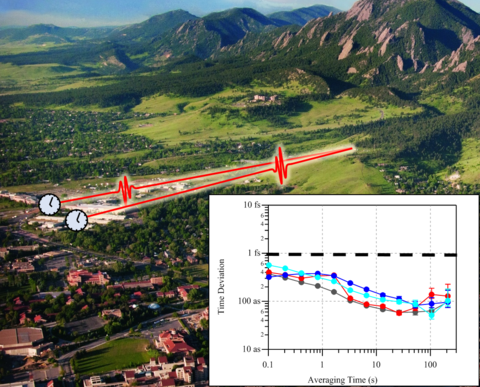Summary
This project aims to develop techniques for precise time-frequency transfer across free-space to support future optical clock networks.
Description

Optical two-way time-frequency transfer (OTWTFT) is being developed on the NIST campus. In most tests, two “optical clocks” or time bases are co-located in the NIST rooftop laboratory and connected via a folded free-space link. The two timebases can be actively synchronized to much better than a femtosecond despite turbulence and even rapid motion (25 m/s), introduced by a retroreflector mounted on a flying quadcopter.
Researchers in the Fiber Sources and Applications Group have been developing the technique of “Optical Two-Way Time-Frequency Transfer” (OTWTFT) which can link time between distant clocks to the femtosecond level over free-space links. Optical clock networks could enable tests of fundamental physics including general relativity, greatly increased sensitivity in coherent sensing, thousand-fold improvement in precision timing and navigation, and the distribution of an optically-defined time standards. With this goal in mind, researchers have developed the technique of comb-based OTWTFT over free space. This approach is the optical analog of rf-based two-way satellite time-frequency transfer. It exploits the reciprocity (equality) in the time-of-flight for light to travel each direction across a single-mode link regardless of turbulence. Following the original Einstein clock synchronization scheme, OTWTFT has synchronized distant optical and microwave-based clocks over free-space links to below a femtosecond even in the presence of strong turbulence over 12-km across Boulder. Carrier-phase OTWTFT can support comparisons of 10-17 at one second, sufficient for the very best optical clocks. Most recently, researchers have been exploring OTWTFT in the presence of motion, which causes both fundamental and systematic breakdown in reciprocity. Nevertheless, femtosecond level OTWTFT has been successfully demonstrated to a retroreflector mounted on a flying quadcopter.

